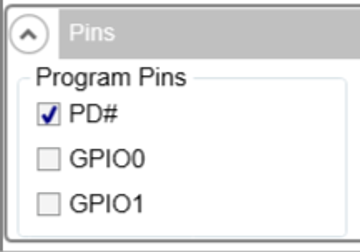SNAU296 December 2023 LMK5C33414A
- 1
- Abstract
- Trademarks
- 1Introduction
- 2EVM Quick Start
- 3EVM Configuration
-
4EVM
Schematics
- 4.1 Power Supply Schematic
- 4.2 Alternative Power Supply Schematic
- 4.3 Power Distribution Schematic
- 4.4 LMK5C33414A and Input References IN0 to IN3 Schematic
- 4.5 Clock Outputs OUT0 to OUT3 Schematic
- 4.6 Clock Outputs OUT4 to OUT9 Schematic
- 4.7 Clock Outputs OUT10 to OUT13 and Clock Inputs IN2 and IN3 Schematic
- 4.8 XO Schematic
- 4.9 Logic I/O Interfaces Schematic
- 4.10 USB2ANY Schematic
- 5EVM Bill of Materials
-
6Appendix A - TICS Pro LMK5C33414A Software
- 6.1 Using the Start Page
- 6.2 Using the Status Page
- 6.3 Using the Input Page
- 6.4 Using APLL1, APLL2, and APLL3 Pages
- 6.5 Using the DPLL1, DPLL2, and DPLL3 Pages
- 6.6 Using the Validation Page
- 6.7 Using the GPIO Page
- 6.8 SYNC/SYSREF/1-PPS Page
- 6.9 Using the Outputs Page
- 6.10 EEPROM Page
- 6.11 Design Report Page
3.4 Generating SYSREF Request
Standard SPI/I2C programming, GPIO0, or GPIO1 can be used to generate a SYSREF request. The TICS Pro software and EVM is designed to use GPIO2 for SPI readback (SDO). Accordingly, GPIO2 is not listed in the pins as GPIO2 is dedicated for SPI readback. In a user application, any GPIO pin can be used.
Connect the desired GPIO pin to the MCU by setting S2 as ON on the switch block for the desired GPIO. Then, make sure the GPIO pin is configured for SYSREF_REQ on the GPIO tab of the GUI. A SYSREF Request can now be issued by toggling the GPIO buttons in the Pins section of the User Controls tab.
 Figure 3-7 GPIO Setting for SYSREF Request
Figure 3-7 GPIO Setting for SYSREF Request Figure 3-8 GPIO Pin Selection for SYSREF
Figure 3-8 GPIO Pin Selection for SYSREF